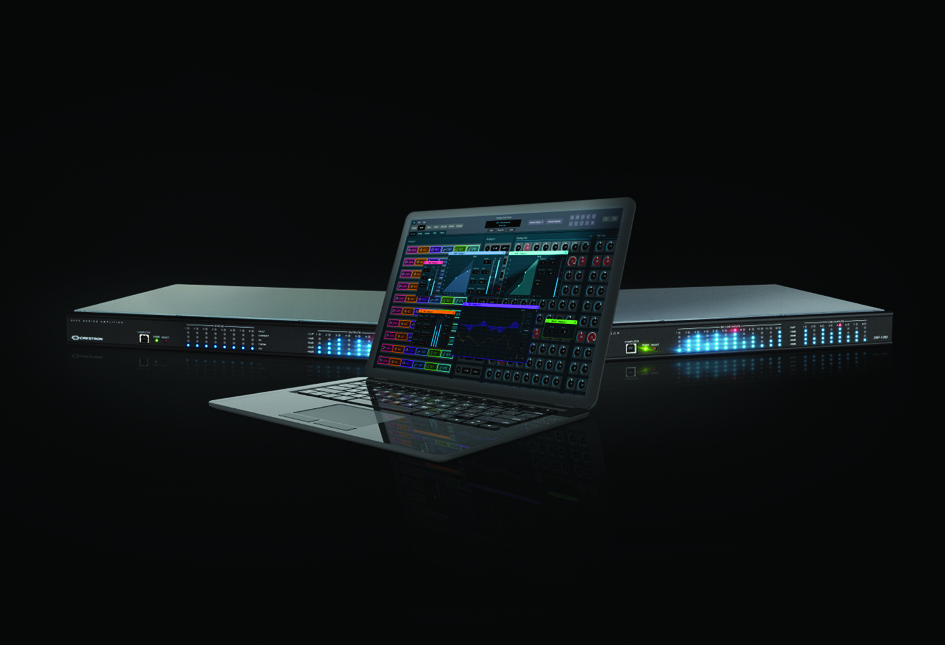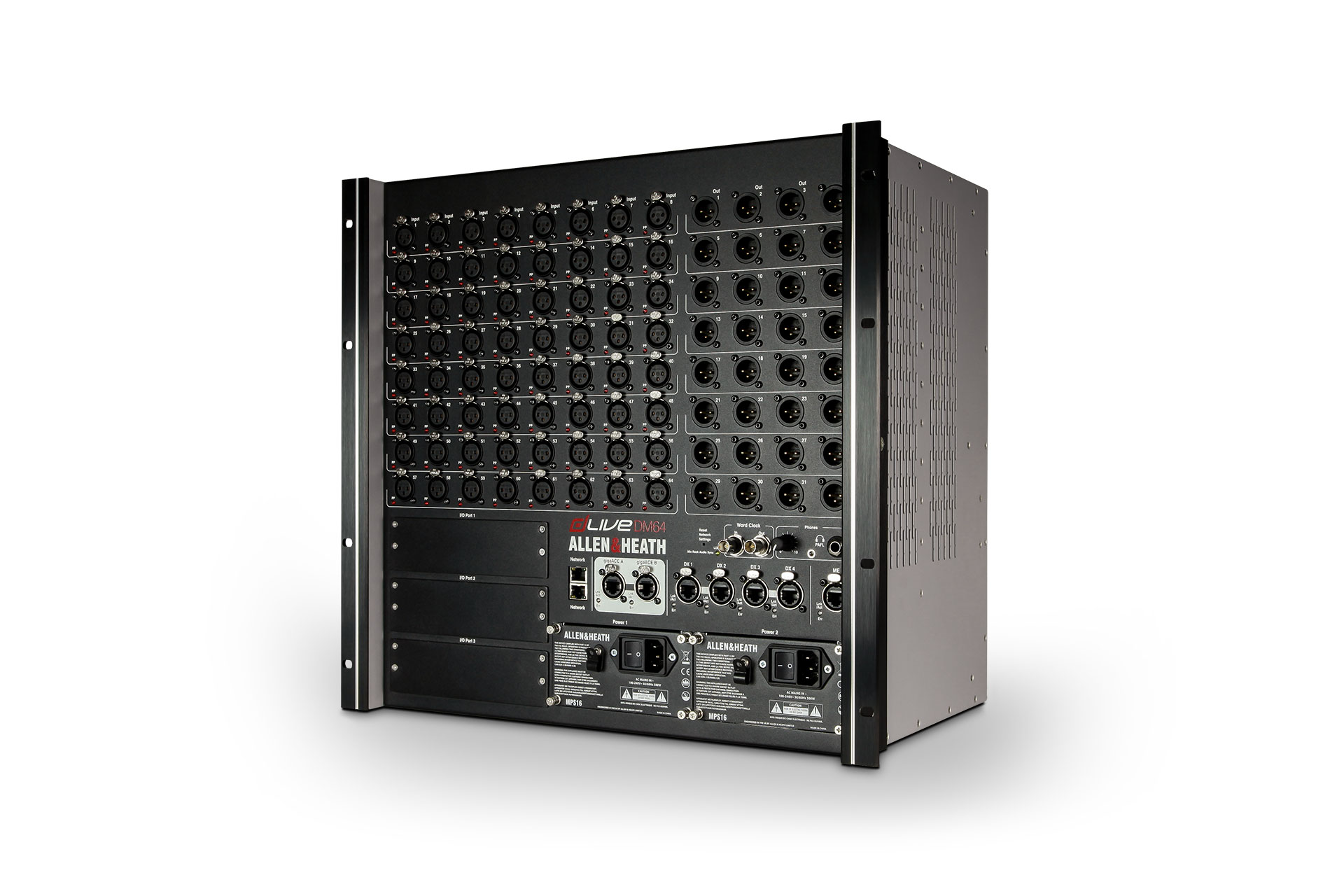The digital age has blurred the lines between applications in many fields, including audio. Where once a distributed audio system meant low-voltage loudspeakers with transformers and skeins of wire, these days such a setup is as likely to be AoIP-networked and controlled by a centralized DSP system.
Of course, low-voltage speakers still exist and are being installed daily. But these days it’s not unusual for them to be just one component of a much larger system that, 20 years ago, might have seemed like science fiction.
Consider Crestron’s distributed audio products, for example. The company’s Avia AMP line includes eight-output amplifiers (75W or 150W per channel) that can output high- or low-Z or a mix, but are network-controlled and Crestron XiO Cloud-connected, with provisions for a dashboard and statistics monitoring, says Ekin Binal, Crestron’s technology manager, audio solutions.
Key to the system are the Avia DSP boxes, available in various analog and USB I/O configurations with built-in Dante networking. Naturally, the system offers easy integration with the many controller options on which Crestron has built its brand.
Avia also offers a comprehensive conferencing feature set, Binal noted. “We’ve seen a huge adoption into the conference room, so we focused this past year on simplifying those setups. In February, we’re coming out with a new software release that will provide a wizard.” Select the components and conferencing method—SIP, POTS, USB—and hit Go: “We create that project within seconds.”
Quick software setup is supported by the Avia Tool, with easy drag-and-drop configuration. But the user interface can dig deeper, displaying channel strip processing, if desired. “What sets us apart is that we have a real-time analyzer built into the platform,” said Binal. This analyzer enables the installer to tune each room without having to lug around additional test and measurement gear.
QSC’s Q-SYS is a software-based audio, video, and control platform available in three tiers of Core processors, with options for in-room processing and built-in I/O, all the way up to centralized processors running on off-the-shelf Dell Server technology in the data center with networked I/O endpoints located locally, according to a company spokesperson. The company also offers native network peripherals for the platform, including power amplifiers, video endpoints, touchscreens, conference cameras, paging stations, and USB endpoints for soft codec integration—all offering easy hardware and software integration.
“Aside from its native Q-LAN protocol suite, Q-SYS supports AES67-enabled devices while providing edge network support for Dante, AVB, and CobraNet,” says Trevor Wagner, product manager, Q-SYS Audio, QSC. “From a control perspective, Q-SYS is an open scripting engine that allows Q-SYS to control nearly any networked third-party device that has an available API, such as lighting, HVAC, or wireless microphones, and also allows other third-party control platforms to control elements of Q-SYS.”
Because Q-SYS offers audio, video, and control in a single processor, said Wagner, “it eliminates unnecessary programming and costly points of failure common to interconnecting separate audio DSP, control processor hardware, and video peripherals. Q-SYS also offers tools that significantly expedite system deployment.”
Allen & Heath’s previous DSP products essentially laid the groundwork for its Qu Series and dLive digital mixing systems. Qu is an affordable fixed, 32-channel DSP, according to Jeff Hawley, marketing manager for Allen & Heath USA (A&H). “Far from being ‘just a mixing console,’ dLive is a complete ecosystem of distributed audio, processing, and control options.”
A choice of seven DSP mix engines may be mixed and matched with any of the six dLive console surface variants, plus portable stageboxes, modular expanders, and PoE-enabled remote controllers. “System-wise, the dLive is capable of running 808 analog inputs and 728 analog outputs within our own protocol,” Hawley said. “Due to our I/O slot configuration—up to five slots of 128 bidirectional channels each—we can interface with other audio protocols and adapt and expand quickly if there are new developments.”
[Lord’s Church LA Levels Up with Allen & Heath dLive]
Dante, SoundGrid, DX, and gigaACE are available as networkable audio protocols, said Hawley. “And we have a range of TCP/IP-based control panels, a networkable GPIO module, and we integrate directly with Shure Axient-D, ULX-D, and QLX-D” wireless mic systems.
For an integrator, he added, “The advantage of using dLive DM MixRacks is that all the programming hooks are already defined. This makes it quite simple to give a controller programmer the info they need, even before the DSP programmer has started to work on the project.” All IP controllers and I/O boxes have a unique feature called Automatic Firmware Matching, he said, which automatically matches the firmware of devices connected to the MixRack via update or downgrade over the network.
Another important feature of Q-SYS is its ability to integrate with cloud-based soft codec applications including Zoom, Skype for Business, and WebEx, said Wagner. “Q-SYS provides the ability for plug-and-play access to a room’s audio and video camera streams without the need for any special device drivers,” enabling users to simply plug in a single USB cable from their laptop to a Q-SYS I/O-USB Bridge and launch their application.
Indeed, Q-SYS provided a simple way for Medallia to integrate Zoom and all meeting room devices without the need for additional hardware at its global headquarters in San Mateo, CA (an SCN Install of the Year 2018). The single-ecosystem install includes QSC loudspeakers and network amplifiers, which greatly reduced design commissioning time and cost, and simplifies user training and support. As Wagner pointed out, “Q-SYS and Q-SYS network amplifiers—along with a collection of offline DSP amplifiers and business mixer processors—have the ability to deliver custom QSC voicings to a complete suite of QSC installation loudspeakers.”
Offering a generic leisure center application, Hawley noted that an A&H engine such as the CDM32 could distribute audio over Dante to ceiling speakers in multiple areas—cardio room, changing rooms, offices, and so on—while driving over audio cable to larger speaker systems in the sports hall, dance studio, and café. Local inputs might include a paging system, area microphones, or DJ equipment, while zoned remote control could be enabled to multiple wireless tablets.
For distributed audio applications, Crestron also manufactures various in-ceiling speaker options. “If you want eight zones of 70V or 100V speakers, and tap them at different values, you can mix and match these Avia commercial amplifiers, keeping it as simple as possible through our software platform,” said Binal. “So we’re continuing to add hooks into our amplifiers.”
[Crestron Masters 2018 Bridges Gap Between Designers, Programmers]
In the coming year, he continued, “stay tuned for Audio over IP connections to the line. We’re really looking at how we can scale up the whole lineup.” New for 2019, he also noted, will be 4 x 600W and 2 x 8002 Avia amplifier models intended to drive the company’s larger speakers, designed in partnership with Fulcrum Acoustics.
“We know how to get the best flat response out of our speakers, so we’ve created speaker profiles. If you’re using our Saros 8-inch in-ceiling speaker, we’ve provided the curves for that,” said Binal. In the upcoming software release, those profiles will be built into the Avia Tool. “Drag and drop those speakers and the DSP will automatically EQ those for a flat response and a good starting point for tuning the room. Because we control the ecosystem from the control to DSP to speakers, we can give you the best-case scenario to get up and running.”


